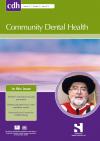Community Dental Health

- Cover Date:
- June 2015
- Print ISSN:
- 0265 539X
- Vol:
- 32
- Issue:
- 2
Are Stage of Change constructs relevant for subjective oral health in a vulnerable population?
© BASCD 2014 doi:10.1922/CDH_3439Jamieson
Are Stage of Change constructs relevant for subjective oral health in a vulnerable population?
L.M. Jamieson, E.J. Parker, J. Broughton, H.P. Lawrence and J.M. Armfield
Stage of Change constructs may be proxy markers of psychosocial health which, in turn, are related to oral health. Objective: To determine if Stage of Change constructs were associated with subjective oral health in a population at heightened risk of dental disease. Methods: Stage of Change constructs were developed from a validated 18-item scale and categorised into ‘Pre-contemplative’, ‘Contemplative’ and ‘Active’. A convenience sample of 446 Australian non-Aboriginal women pregnant by an Aboriginal male (age range 14–43 years) provided data to evaluate the outcome variables (self-rated oral health and oral health impairment), the Stage of Change constructs and socio-demographic, behavioural and access-related factors. Factors significant at the p<0.05 level in bivariate analysis were entered into prevalence regression models. Results: Approximately 54% of participants had fair/poor self-rated oral health and 34% had oral health impairment. Around 12% were ‘Pre-contemplative’, 46% ‘Contemplative’ and 42% ‘Active’. Being either ‘pre-contemplative’ or ‘contemplative’ was associated with poor self-rated oral health after adjusting for socio-demographic factors. ‘Pre-contemplative’ ceased being significant after adjusting for dentate status and dental behaviour. ‘Pre-contemplative’ remained significant when adjusting for dental cost, but not ‘Contemplative’. The Stages of Change constructs ceased being associated with self-rated oral health after adjusting for all confounders. Only ‘Contemplative’ (reference: ‘Active’) was a risk indicator in the null model for oral health impairment which persisted after adding dentate status, dental behaviour and dental cost variables, but not socio-demographics. When adjusting for all confounders, ‘Contemplative’ was not a risk indicator for oral health impairment. Conclusions: Both the ‘Pre-contemplative’ and ‘Contemplative’ Stage of Change constructs were associated with poor self-rated oral health and oral health impairment after adjusting for some, but not all, covariates. When considered as a proxy marker of psychosocial health, Stage of Change constructs may have some relevance for subjective oral health.
Key words: stage of change, oral health, pregnancy, Australia, Aboriginal
- Article Price
- £15.00
- Institution Article Price
- £
- Page Start
- 111
- Page End
- 116
- Authors
- E.J. Parker, J. Broughton, H.P. Lawrence, J.M. Armfield
Articles from this issue
- Title
- Pg. Start
- Pg. End
- Dentists’ knowledge of oral health during pregnancy: a review of the last 10 years’ publications
- 77
- 82
- A pilot project to improve the oral health of orphans and of the elderly in residential care in Constanta, Romania
- 89
- 92
- The association between parents’ perceived social norms for toothbrushing and the frequency with which they report brushing their child’s teeth
- 98
- 103
- Are Stage of Change constructs relevant for subjective oral health in a vulnerable population?
- 111
- 116
